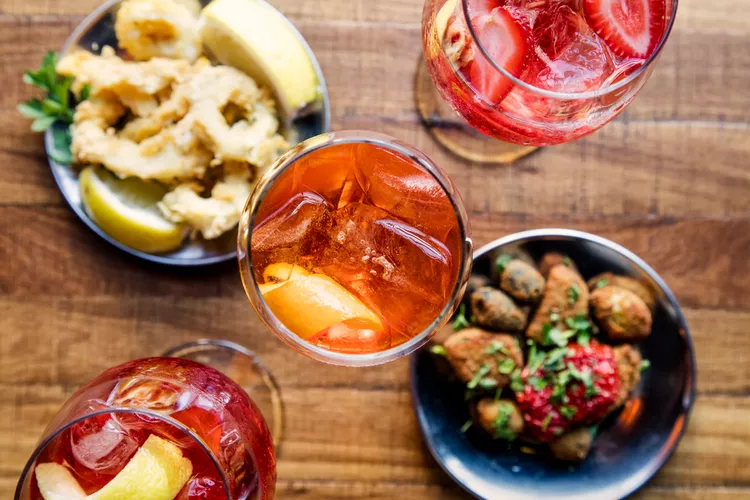Aperitivo: The Italian Pre-Dinner Tradition
The tradition of aperitivo originated in Italy several hundred years ago and continues in various forms around the world today.

Customs and practices associated with dining and drinks continuously evolve over time and place. The popularity of food delivery and elaborate take-out meals was on the rise even before the pandemic shut down restaurants. Moreover, diet styles like vegan, vegetarian, paleo, and zero-carb are becoming mainstream in certain areas. Cocktails have transformed into complex recipes with numerous ingredients — a stark contrast to the simple highball, scotch and soda, and rum and Coke of the past. One widely enjoyed custom associated with dining and drinking, aperitivo, has its roots in Italy and persists in varied forms globally.
Aperitivo refers to a drink, typically wine or a light mixed cocktail, paired with a small meal at the end of the workday, serving as a prelude to dinner. In Italy, where dinner is usually consumed later than in the U.S., the typical time for aperitivo is around 7-9 p.m. The drink and accompanying snack are designed to stimulate the appetite and prepare guests for the meal. Therefore, the drinks are often herbal, bitter, or sparkling. It’s important to note that while there might be similarities, aperitivo is distinct from happy hour, typically occurring from 4-6 p.m., where drinks are discounted and food is abundant, often substituting for dinner.
According to Los Angeles-based wine and food educator Giammario Villa, “It’s not possible to pinpoint a specific date for the beginning of aperitivo, but it’s a social experience that began around the late 1700s.”
Antonio Benedetto Carpano, a distiller from Torino, is credited with creating vermouth in 1786, blending fortified wine with various aromatic herbs and spices. Considered a widely sipped aperitivo drink, this was a natural development due to the abundant local herbs available in Piedmont, coupled with its rich winemaking tradition.
Following this, the café emerged as a social hub where people gathered to enjoy local delicacies like cured meats and cheeses alongside a glass of vermouth at the end of their workday. In Italy, aperitivo crowds typically congregate in the piazza, osteria, or café, with different regions adopting various beverages throughout its evolution.
In 1860, Gaspare Campari introduced his eponymous vibrant red, bitter beverage, commonly served as an aperitivo with soda water or in cocktails like the Negroni and Americano. Although the exact recipe for Campari remains confidential, it includes bitter herbs, aromatic plants, and fruit combined with alcohol and water.
Approximately around the same time, Alessandro Martini and Luigi Rossi melded herbs and aromatic botanicals to create their inaugural vermouth, Martini & Rossi Rosso. Their original recipe, unchanged for over 150 years, remains closely guarded. Currently, Martini & Rossi offers a range of vermouths and sparkling wines, with their latest addition being Fiero, an aperitivo vermouth characterized by vivid color and citrus notes.
Generally, aperitivo drinks exhibit bitter, herbal notes and are low in alcohol content. Vermouth and other wines, including increasingly popular sparklers like prosecco, are frequently ordered. Bitter flavors are associated with stimulating the appetite, whereas light foods enhance the dining experience. The term aperitivo derives from aperire, Latin for “open.” Villa noted that many aperitivo snacks consist of fried or fatty items, such as cheeses, prosciutto, and mortadella, making sparkling wines ideal palate cleansers.
The Most Popular Cocktail in Every State, According to Google
Aperol, the bright orange ingredient in the spritz, is also bitter and, when combined with prosecco, a splash of soda, and an orange slice, has become a globally beloved drink since its introduction in Veneto. Although Aperol’s origins date back to 1919, the original spritz — a combination of wine with soda water — was initially favored by Veneto-based Austrian soldiers who considered Italian wines too potent.
A more recent addition to the aperitivo scene is Italicus Rosolio di Bergamotto, based on an 1800s recipe that incorporates Italian bergamot, rose, lavender, and other flavors, showcased in a stunning aqua bottle. This drink delivers a bitter, floral experience and pairs well with prosecco or tonic, particularly when garnished with green olives.
If you ever find yourself in a Roman piazza or along a Venetian canal in the early evening — a delightful thought indeed — consider settling in for aperitivo at a local café. Choose a glass of vermouth, prosecco, or a cocktail and observe as the crowd gathers and conversations flourish. Aperitivo is inherently social; therefore, it’s best enjoyed with company. You may receive a small serving of something to complement your beverage, or, if a buffet-style arrangement is available, help yourself to a plate of cheese, meat, bread, or the offerings of the day. Conventionally, one plate per drink is considered appropriate, and it’s customary to settle your bill as you are served, assisting wait staff in maintaining their workflow.
Once your appetite for dinner is ignited, wander through the piazza to discover the ideal restaurant, a cozy table, and an enticing menu alongside a glass of exquisite Italian wine to elevate your meal experience.





